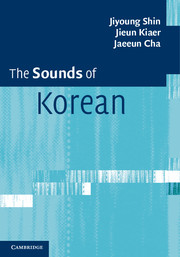Book contents
- Frontmatter
- Contents
- Figures
- Tables
- Preface
- Notational conventions
- 1 Characteristics of the Korean language
- 2 Production of sounds
- 3 Basic concepts of phonology
- 4 Consonants
- 5 Vowels
- 6 Frequency trends of Korean sounds
- 7 Prosody
- 8 Phonological rules of Korean (I)
- 9 Phonological rules of Korean (II)
- 10 Loanword phonology
- Notes
- Bibliography
- Index
1 - Characteristics of the Korean language
Published online by Cambridge University Press: 05 November 2012
- Frontmatter
- Contents
- Figures
- Tables
- Preface
- Notational conventions
- 1 Characteristics of the Korean language
- 2 Production of sounds
- 3 Basic concepts of phonology
- 4 Consonants
- 5 Vowels
- 6 Frequency trends of Korean sounds
- 7 Prosody
- 8 Phonological rules of Korean (I)
- 9 Phonological rules of Korean (II)
- 10 Loanword phonology
- Notes
- Bibliography
- Index
Summary
In this chapter, we will provide an overview of the Korean language and briefly discuss its main characteristics. In 1.1, we will discuss the origin, history and distribution of the Korean language; in 1.2, the Korean alphabet and its romanisation will be discussed; 1.3 focuses on the characteristics of the Korean lexicon; in 1.4, the structural characteristics of Korean will be explored; and in 1.5, the socio-pragmatic characteristics of Korean will be discussed.
Origin, history and distribution
The Korean language in East Asian history
It is impossible to think about the history of Korea without considering the history of Northeast Asia. In the same vein, the history of the Korean language cannot be considered without reference to the influence of Korea’s neighbours; namely, China, Japan and Mongolia. Figure 1.1 shows how the Korean language has evolved from Old Korean into Contemporary Korean within the bigger picture of East Asian history. The classification is based on K.-M. Lee (1998).
- Type
- Chapter
- Information
- The Sounds of Korean , pp. 1 - 15Publisher: Cambridge University PressPrint publication year: 2012



